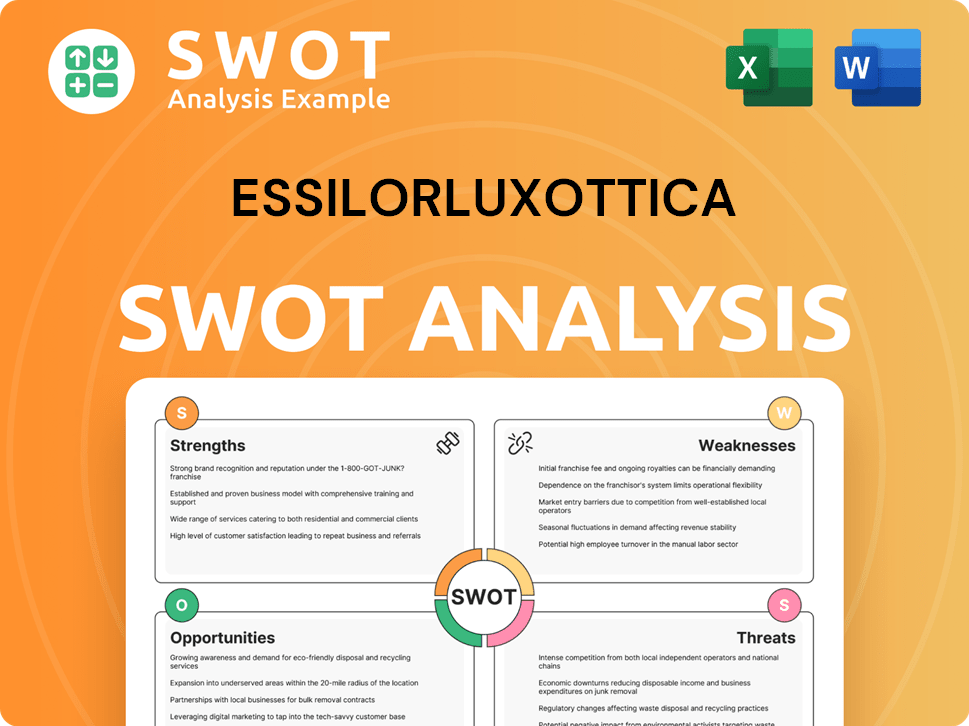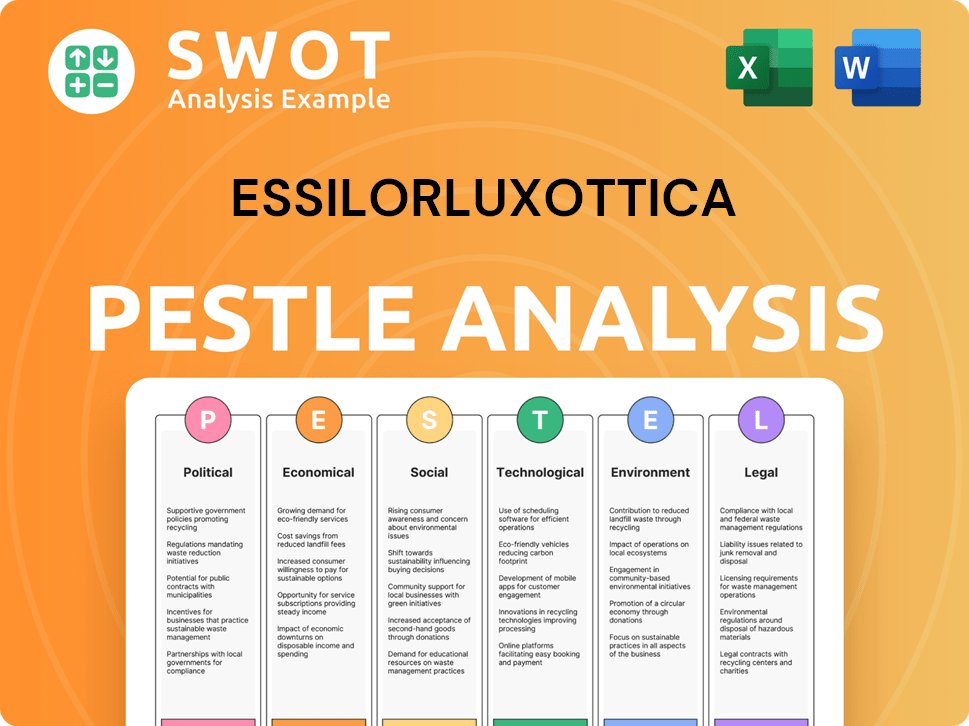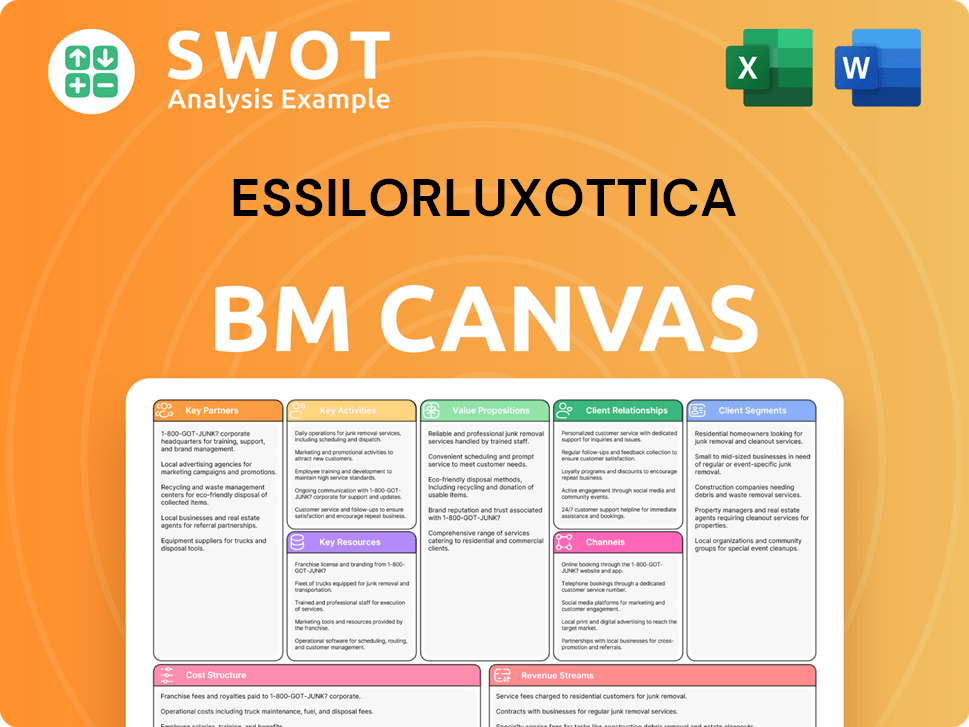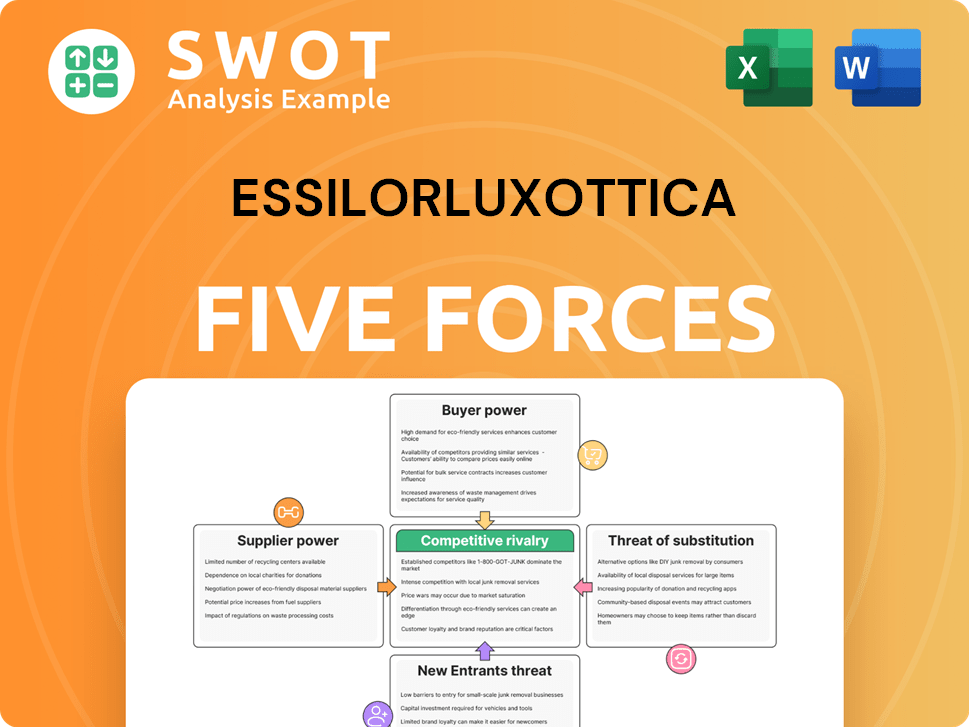EssilorLuxottica Bundle
How Did EssilorLuxottica Reshape the Eyewear World?
The story of EssilorLuxottica is a captivating tale of two industry titans converging to dominate the global optical industry. This powerful merger in 2018 created a behemoth, but its roots stretch back decades, with each company initially pursuing distinct paths in vision care and eyewear fashion. Understanding the EssilorLuxottica SWOT Analysis helps to understand its evolution.

Delving into the brief history of EssilorLuxottica reveals a strategic consolidation driven by innovation and brand power. From its early beginnings, the company's journey showcases a remarkable transformation, impacting the eyewear market significantly. This evolution, marked by key milestones and acquisitions, has cemented EssilorLuxottica's position as a global leader.
What is the EssilorLuxottica Founding Story?
The EssilorLuxottica story is a tale of two entrepreneurial journeys that converged to reshape the optical industry. It began with the separate, yet equally ambitious, visions of two companies: Essilor and Luxottica. Their eventual merger created a global powerhouse in the eyewear brands market.
Essilor's roots trace back to the 1972 merger of Essel and Silor, both French companies. Essel, established in 1849, was a pioneer in ophthalmic optics, while Silor, founded in 1931, brought expertise in plastic lenses. This union aimed to create a stronger entity in the ophthalmic lens market, responding to the need for advanced vision correction solutions. Luxottica, on the other hand, was founded on May 27, 1961, by Leonardo Del Vecchio in Agordo, Italy.
Del Vecchio, an orphan who started as a toolmaker, saw an opportunity in the eyewear manufacturing industry. His initial focus was on creating high-quality metal components for other eyewear companies before shifting to complete frames. Both companies were born from distinct cultural and economic contexts: Essilor from the French tradition of optical excellence, and Luxottica from the post-war Italian entrepreneurial spirit that valued craftsmanship and design.
The early years of both companies set the stage for their future. Essilor focused on innovation in lenses, while Luxottica built its foundation on manufacturing excellence.
- Essilor: Emerged from the 1972 merger of Essel and Silor, both French companies.
- Luxottica: Founded in 1961 by Leonardo Del Vecchio in Italy.
- Early Focus: Essilor on advanced vision correction; Luxottica on high-quality eyewear components and later, complete frames.
- Funding: Luxottica primarily bootstrapped, reinvesting profits; Essilor benefited from the combined resources of Essel and Silor.
Del Vecchio's initial business model for Luxottica was contract manufacturing, leveraging his precision engineering skills. He soon transitioned to designing and manufacturing his own eyewear collections, seeking greater control over the product and its quality. Essel and Silor focused on the growing demand for innovative ophthalmic lenses, with Essel having already made strides with its Varilux progressive lens in 1959. The name 'Luxottica' was chosen to evoke luxury and optical precision. For a broader understanding of the competitive environment, consider exploring the Competitors Landscape of EssilorLuxottica.
EssilorLuxottica SWOT Analysis
- Complete SWOT Breakdown
- Fully Customizable
- Editable in Excel & Word
- Professional Formatting
- Investor-Ready Format

What Drove the Early Growth of EssilorLuxottica?
The early growth of EssilorLuxottica, a story of the Owners & Shareholders of EssilorLuxottica, is a tale of innovation and strategic expansion. Essilor's initial focus on research and development, particularly in progressive lenses, set the stage for its future success. Luxottica, on the other hand, transformed the eyewear industry by integrating manufacturing and retail, and establishing partnerships with major fashion brands.
Essilor's early success was significantly shaped by its commitment to research and development. The introduction of the Varilux lens before the merger revolutionized vision correction for presbyopia. Following the 1972 merger, Essilor expanded internationally, establishing subsidiaries and distribution networks across Europe, North America, and Asia, solidifying its position in the optical industry. Key acquisitions in the 1980s and 1990s further broadened its product portfolio and market reach.
Luxottica evolved from a components manufacturer to a fully integrated eyewear company. In the 1970s, Luxottica started manufacturing complete frames. The 1980s saw the company enter licensing agreements with major eyewear brands, transforming eyeglasses into fashion accessories. The acquisition of LensCrafters in 1995 and Ray-Ban in 1999, were monumental milestones, giving Luxottica direct access to consumers and iconic eyewear brands.
The acquisition of LensCrafters and Ray-Ban propelled Luxottica into a dominant position in both wholesale and retail. This allowed the company to control a significant portion of the eyewear value chain. These strategic moves enabled Luxottica to expand its global presence and market share significantly. As of 2024, the company continues to hold a leading position in the global eyewear market.
Both Essilor and Luxottica experienced significant team expansion and established numerous manufacturing facilities and distribution centers globally. Adapting to market demands and competitive pressures through strategic investments and a relentless pursuit of innovation has been a key factor. This global presence is a testament to their effective strategies.
EssilorLuxottica PESTLE Analysis
- Covers All 6 PESTLE Categories
- No Research Needed – Save Hours of Work
- Built by Experts, Trusted by Consultants
- Instant Download, Ready to Use
- 100% Editable, Fully Customizable

What are the key Milestones in EssilorLuxottica history?
The company history of EssilorLuxottica is a story of strategic moves and significant growth within the optical industry. This began with the individual successes of Essilor and Luxottica, which eventually led to their historic merger. The journey of EssilorLuxottica has been marked by key milestones, innovative product developments, and the resolution of complex challenges.
| Year | Milestone |
|---|---|
| 1959 | Essel, later Essilor, introduced the Varilux lens, the first progressive lens, revolutionizing vision correction. |
| 1960s-2000s | Luxottica expanded its brand portfolio through licensing agreements and acquisitions, including Ray-Ban and Oakley, establishing a strong retail presence. |
| 2018 | The merger of Essilor and Luxottica created EssilorLuxottica, a global leader in the eyewear market. |
| 2020-2024 | EssilorLuxottica focused on integrating operations, expanding its global footprint, and innovating in lens and frame technologies. |
Essilor's commitment to innovation is evident in its lens technology advancements. These include anti-reflective coatings, photochromic lenses, and high-index materials, which have significantly improved the quality of vision correction.
The introduction of Varilux progressive lenses in 1959 was a major breakthrough, offering a solution for presbyopia. These lenses provided clear vision at all distances without the visible lines of bifocals.
Essilor developed and improved anti-reflective coatings to reduce glare and reflections on lenses. This enhances visual clarity and improves the wearer's experience, especially in low-light conditions.
Through a joint venture, Essilor contributed to the development of photochromic lenses, such as Transitions, which automatically darken in sunlight. This offers convenience and protection from UV rays.
Essilor utilized high-index materials to create thinner and lighter lenses, improving comfort and aesthetics. These lenses are particularly beneficial for people with strong prescriptions.
The company uses digital surfacing technology to create more precise and customized lenses. This allows for better vision correction tailored to individual needs.
Continuous research and development have led to advanced lens designs that address various vision problems, including those related to digital eye strain and age-related macular degeneration.
The challenges faced by EssilorLuxottica include managing a complex global supply chain and adapting to shifts in retail landscapes. The company also contends with intense competition and the need for continuous innovation to maintain its market position. The integration of two large corporations, as detailed in Revenue Streams & Business Model of EssilorLuxottica, presented unique operational and cultural hurdles.
Managing a complex global supply chain, from raw materials to finished products, is crucial for efficiency and cost control. Disruptions can impact production and distribution.
Adapting to changes in the retail environment, including the growth of online sales and changing consumer preferences, is essential. This requires strategic investments in both online and offline channels.
The eyewear market is highly competitive, with numerous brands and manufacturers vying for market share. Differentiation through innovation and branding is critical.
The merger of Essilor and Luxottica involved integrating two large companies with distinct cultures and operations. This requires careful planning and execution to achieve synergies.
Combating counterfeiting of eyewear products is an ongoing challenge. Protecting intellectual property and ensuring product authenticity are important for brand reputation.
Economic downturns and currency fluctuations can affect consumer spending and profitability. Diversification and global presence help mitigate these risks.
EssilorLuxottica Business Model Canvas
- Complete 9-Block Business Model Canvas
- Effortlessly Communicate Your Business Strategy
- Investor-Ready BMC Format
- 100% Editable and Customizable
- Clear and Structured Layout

What is the Timeline of Key Events for EssilorLuxottica?
The EssilorLuxottica company history is marked by strategic mergers and acquisitions, leading to its position as a global leader in the optical industry. The evolution of the company, from its early beginnings to its current status, showcases a commitment to innovation and market dominance. Key milestones highlight the strategic decisions that shaped the organization into the world's largest eyewear company.
| Year | Key Event |
|---|---|
| 1959 | Essel introduced the Varilux progressive lens, revolutionizing vision correction. |
| 1961 | Leonardo Del Vecchio founded Luxottica, marking the beginning of a major eyewear company. |
| 1972 | Essel and Silor merged to form Essilor, creating a strong player in the lens market. |
| 1995 | Luxottica acquired LensCrafters, expanding its retail presence significantly. |
| 1999 | Luxottica acquired Ray-Ban, adding a globally recognized brand to its portfolio. |
| 2018 | Essilor and Luxottica merged to form EssilorLuxottica, creating an industry giant. |
| 2021 | EssilorLuxottica completed the acquisition of GrandVision, further solidifying its market position. |
EssilorLuxottica continues to invest heavily in research and development. This includes advanced lens technologies and smart eyewear. The company is focused on creating cutting-edge vision care solutions. In 2023, R&D spending reached approximately €600 million, demonstrating a strong commitment to future advancements.
Expanding its presence in emerging markets is a key strategic focus. EssilorLuxottica aims to increase access to vision care globally. The company is targeting significant growth in regions like Asia-Pacific and Latin America. The Asia-Pacific region accounted for around 30% of total revenue in 2024.
Enhancing the customer journey through retail and e-commerce platforms. The goal is to provide seamless omnichannel experiences. This includes integrating online and in-store services. E-commerce sales are projected to grow by approximately 15% in 2025.
The increasing global demand for vision correction is a key driver. This is due to an aging population and increased screen time. Awareness of eye health is also growing, boosting the demand for vision care products. The global eyewear market is expected to reach $200 billion by 2027.
EssilorLuxottica Porter's Five Forces Analysis
- Covers All 5 Competitive Forces in Detail
- Structured for Consultants, Students, and Founders
- 100% Editable in Microsoft Word & Excel
- Instant Digital Download – Use Immediately
- Compatible with Mac & PC – Fully Unlocked

Related Blogs
- What is Competitive Landscape of EssilorLuxottica Company?
- What is Growth Strategy and Future Prospects of EssilorLuxottica Company?
- How Does EssilorLuxottica Company Work?
- What is Sales and Marketing Strategy of EssilorLuxottica Company?
- What is Brief History of EssilorLuxottica Company?
- Who Owns EssilorLuxottica Company?
- What is Customer Demographics and Target Market of EssilorLuxottica Company?
Disclaimer
All information, articles, and product details provided on this website are for general informational and educational purposes only. We do not claim any ownership over, nor do we intend to infringe upon, any trademarks, copyrights, logos, brand names, or other intellectual property mentioned or depicted on this site. Such intellectual property remains the property of its respective owners, and any references here are made solely for identification or informational purposes, without implying any affiliation, endorsement, or partnership.
We make no representations or warranties, express or implied, regarding the accuracy, completeness, or suitability of any content or products presented. Nothing on this website should be construed as legal, tax, investment, financial, medical, or other professional advice. In addition, no part of this site—including articles or product references—constitutes a solicitation, recommendation, endorsement, advertisement, or offer to buy or sell any securities, franchises, or other financial instruments, particularly in jurisdictions where such activity would be unlawful.
All content is of a general nature and may not address the specific circumstances of any individual or entity. It is not a substitute for professional advice or services. Any actions you take based on the information provided here are strictly at your own risk. You accept full responsibility for any decisions or outcomes arising from your use of this website and agree to release us from any liability in connection with your use of, or reliance upon, the content or products found herein.